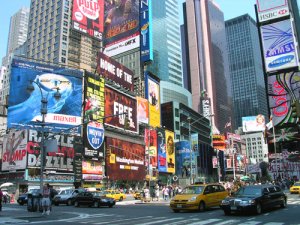Advertisements are everywhere. Cabs and busses are covered in full-size ads, billboards are placed every 50 yards along highways, YouTube now plays ads before you can watch the video you intended, TV events are created out of one-sentence announcements (e.g. Heisman Trophy presentation, American Idol final), pop-ups pervade web browsing while we simultaneously find ads for pop-up blocker applications, high school prom dances turn into ads for the usefulness of duct tape, and people are ever getting paid to get advertisements tattooed on their bodies. A 2009 study suggests that the average American adult spends over an hour a day watching advertisements on TV alone.
But really, you’ve got to feel sorry for the advertisers, don’t you? Think about it: the more ads that are put into the public domain, the less effective each individual ad becomes.
This stems from the fact that advertisers are competing to satisfy the existing and limited demand of a consumer base, rather than creating new demand. Think of the sheer volume of ads for food and drinks. These companies are not assuming that without advertisements people will just not eat at all; rather, they assume that people are going to eat somewhere, and advertisements are intended to direct the consumers’ demand in their direction.
While there is a certain amount of demand created by advertisements, advertisers aren’t so naïve as to assume that they can convince you, with a single 30-second spot, to buy a brand new car out of the blue. Rather, their primary interest is to direct, and at times exaggerate, a consumer’s existing desires. This means that marketers are essentially competing to win the same consumer demand, and consequently, with each entrance of a new competitor, the old ones have to fight even harder to maintain its market share.
Imagine visiting a city for the first time and getting lost on your way to the hotel. Contrast the following scenarios:
Scenario 1 –You pull over and ask someone for directions. The person says they know where you are intending to go and gives you concise enough directions to follow.
Scenario 2 – You pull over and ask a group of people for directions. They all say that they know where you are intending to go and each gives you concise enough directions that you believe you can execute—however; everyone in the group gives you a different set of directions that lead you to altogether distinct places!
Presumably in scenario 1, you would simply follow the directions you were given, but scenario 2 seems much more confusing. Whose directions are you to follow? The person who has lived in the city the longest? The one who seemed most confident? The one who claimed to be a taxi driver? The one who claimed to be a doctor? The one who was most well dressed? In fact, the situation seems altogether so confusing that you will probably reject all of their opinions and ask a new person or try purchasing a map.
The same confusion arises when advertisers compete for your demands. The more businesses that decide to advertise, the more the existing advertisers have to shout louder, in more places, and in smarter ways in order to get your attention. This ultimately leads to more and more of our dollars and minutes being spent on advertisements every year. We are, in short, in a commercial race to the bottom wherein the more effort that is expended leads to not only fewer gains but higher costs for both businesses and consumers.


Nice RTTB example! It’s possible that this one has a slightly different structure than some others, like the fishing example. In particular, it is not necessarily *the firms* that are caught having to advertise their products that are losing. This is just a cost of doing business, and it is passed along to consumers. And it is certainly not the advertising firms, that exist and profit *because* of the race. The idea, I presume, is that the economy as a whole is less efficient (and social welfare is reduced) because the amount spent on advertising, much of which is unwanted and annoying in addition to being costly and adding to the cost of living.
At the same time, we can’t imagine anything like a modern economy without advertising. So we can’t infer from the inefficiency of the ad-heavy economy that the ad-less economy would be better for consumers. For better or worse, all aspects of consumer demand would be different if there were severe restrictions on firms advertising their products and services. And even in our economy, there is the still the hope, which is substantiated successfully every year, that the right overall marketing campaign will allow your firm to gain a competitive advantage.
It would be interesting to compare some estimates about how much “inefficiency” advertising is responsible for. What percentage of GDP does it account for? Are there examples of any relatively stable consumer-product sectors where rival firms came to realize that overall demand had stabilized and they found they could all cut back on their advertising battles? Are there others where it intensifies as they fight for a bigger and bigger share of a dwindling market?